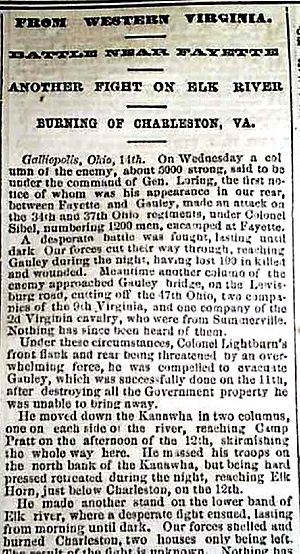Battle of Charleston (1862) facts for kids
Quick facts for kids Battle of Charleston, Va (WV) |
|||||||
|---|---|---|---|---|---|---|---|
| Part of the American Civil War | |||||||
|
|||||||
| Belligerents | |||||||
| Commanders and leaders | |||||||
| Joseph Andrew Jackson Lightburn | William W. Loring John McCausland |
||||||
| Strength | |||||||
| 5,000 | 5,000 | ||||||
| Casualties and losses | |||||||
| 256 | 404 | ||||||
The Battle of Charleston was an important fight during the American Civil War. It happened on September 13, 1862, near Charleston in what is now West Virginia. This battle was part of a bigger plan by the Confederate army to take control of the Kanawha Valley. The Confederates won this battle. It is different from another Battle of Charleston that happened in Missouri in 1861.
Contents
Why Did the Battle Happen?
In the summer of 1862, the Confederate army had a plan. They wanted to move into the Kanawha Valley in western Virginia. Their goal was to capture the city of Charleston.
This plan came about because many Union soldiers had left the area. General Cox and his Kanawha Division moved to help in other battles. These included fights at South Mountain and Sharpsburg (Antietam) in Maryland.
Colonel Joseph Andrew Jackson Lightburn was left in charge of the Union forces. He had soldiers from several states, including West Virginia and Ohio.
The March to Charleston
On September 6, 1862, Confederate General William W. Loring began his march. He had about 5,000 soldiers with him. They started from Narrows, Virginia and headed towards Charleston.
Their journey was not easy. On September 10, they met Union forces near Fayetteville. The Confederates pushed the Union soldiers back towards Charleston.
The chase continued on September 11. The Union forces split up near Gauley's Bridge. They moved along both sides of the Kanawha River. The Confederates also split to keep up the pursuit.
A Confederate officer, Lt. Joel Abbott, destroyed Gauley Bridge. He also blew up an ammunition pile. This made it harder for the Union forces.
The Battle Begins!
On September 12, the Confederates kept pushing forward. They fought through fallen trees that blocked their path. By late afternoon on September 13, the main battle for Charleston began.
The fighting lasted until about 7:30 p.m. General Loring's troops reached the Elk River. The Union forces had destroyed the bridge there. This made it hard for the Confederates to cross.
However, Confederate General John McCausland found a place to cross. He led his cavalry across the Elk River. The Union forces then pulled back across the Kanawha River. They went to Point Pleasant overnight.
After the Battle
The Confederate army took control of Charleston. They stayed there for six weeks. But on October 28, 1862, they began to leave.
About 12,000 Union soldiers were approaching. They came from the northeast counties. Facing such a large force, the Confederates withdrew. The Union army then re-occupied Charleston without a fight.
The battle was a Confederate victory. But their control of Charleston did not last long.
A Closer Look at the Fight
Here's a summary of what happened during the battle, from a historical account:
Colonel John McCausland was ordered to lead a group of Confederate soldiers. His mission was to cross the Kanawha River and push towards Charleston. He crossed the river at Montgomery's Ferry. His cavalry led the way.
McCausland's troops stopped Union efforts to burn salt furnaces. They camped four miles from the ferry. On September 12, McCausland kept moving forward. The Union soldiers tried to block the roads by cutting down trees. This slowed the Confederates down.
On September 13, McCausland continued his pursuit. He moved through Camp Piatt (now Belle) and Maiden. He reached the edge of Charleston. He met Union skirmishers near the Elk River.
McCausland set up his brigade around 3 p.m. His soldiers pushed forward through the town. They reached the Elk River. They found that the Union forces had crossed and destroyed the bridge.
McCausland looked for places to cross the river. During this time, there was heavy fighting. An officer reported that the firing was "terrific." The soldiers fought bravely through yards and fields.
McCausland's cavalry found a ford (a shallow crossing) two miles east of Charleston. They were able to cross the Elk River. But the ford was too deep for his infantry and artillery. Darkness stopped the fighting around 7:30 p.m. The Union soldiers began to retreat from the town.


